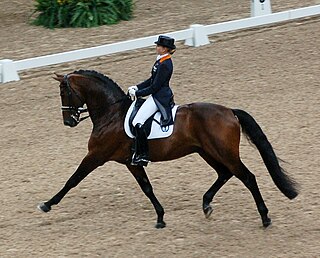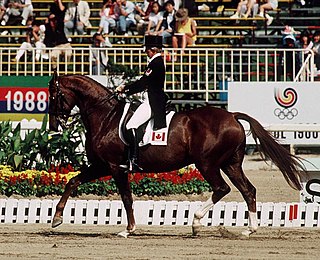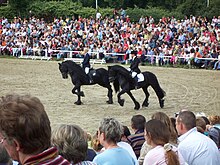
Dressage is a form of horse riding performed in exhibition and competition, as well as an art sometimes pursued solely for the sake of mastery. As an equestrian sport defined by the International Equestrian Federation, dressage is described as "the highest expression of horse training" where "horse and rider are expected to perform from memory a series of predetermined movements.".

Equestrianism, commonly known as horse riding or horseback riding, includes the disciplines of riding, driving, and vaulting. This broad description includes the use of horses for practical working purposes, transportation, recreational activities, artistic or cultural exercises, and competitive sport.

A horse show is a judged exhibition of horses and ponies. Many different horse breeds and equestrian disciplines hold competitions worldwide, from local to the international levels. Most horse shows run from one to three days, sometimes longer for major, all-breed events or national and international championships in a given discipline or breed. Most shows consist of a series of different performances, called classes, wherein a group of horses with similar training or characteristics compete against one another for awards and, often, prize money.

Classical dressage evolved from cavalry movements and training for the battlefield, and has since developed into the competitive dressage seen today. Classical riding is the art of riding in harmony with, rather than against, the horse.

Equitation is the art or practice of horse riding or horsemanship.

The Spanish Riding School is an Austrian institution dedicated to the preservation of classical dressage and the training of Lipizzaner horses, based in Vienna, Austria, whose performances in the Hofburg are also a tourist attraction. The leading horses and riders of the school also periodically tour and perform worldwide. It is one of the "Big Four", the most prestigious classical riding academies in the world, alongside the Cadre Noir, the Portuguese School of Equestrian Art, and the Royal Andalusian School.
Freestyle to Music, originated in 1980 by musician Gaynor Colbourn and GB Olympic Rider Jennie Loriston-Clarke MBE, is a form of dressage competition in which movements are performed to matching music resembling ballet or ice dancing. Movements and figures are choreographed to meet the technical requirements of the particular level with carefully chosen music that highlights the horse-rider combination. Musical Freestyle Dressage entertains and appeals not only to devotees of the sport but also to the general public, which has generated a significant increase in global popularity of Dressage. International level competition comprises Prix St. Georges for Young Riders, Intermediate I and Grand Prix through the Fédération Équestre Internationale (FEI).

Equestrian vaulting, or simply vaulting, is most often described as gymnastics and dance on horseback, which can be practiced both competitively or non-competitively. Vaulting has a history as an equestrian act at circuses, but its origins stretch back at least two-thousand years. It is open to both men and women and is one of ten equestrian disciplines recognized by the International Federation for Equestrian Sports. Therapeutic or interactive vaulting is also used as an activity for children and adults who may have balance, attention, gross motor skill or social deficits.

A double bridle, also called a full bridle or Weymouth bridle, is a bridle that has two bits and four reins. One bit is the bradoon, is a modified snaffle bit that is smaller in diameter and has smaller bit rings than a traditional snaffle, and it is adjusted so that it sits above and behind the other bit, a curb bit. Another term for this combination of curb and snaffle bit is a "bit and bradoon", where the word "bit" in this particular context refers to the curb.

Equestrian sports were first included in the Olympic Games in the Summer Olympics of 1900 in Paris. They were again included in 1912, and have been included in every subsequent edition of the Games. The Olympic equestrian disciplines are dressage, eventing, and show-jumping. In each discipline, both individual and team medals are awarded. Women and men compete on equal terms.

English riding is a form of horse riding seen throughout the world. There are many variations, but all feature a flat English saddle without the deep seat, high cantle or saddle horn that are part of a Western saddle nor the knee pads seen on an Australian Stock Saddle. Saddles within the various English disciplines are all designed to allow the horse the freedom to move in the optimal manner for a given task, ranging from classical dressage to horse racing. English bridles also vary in style based on discipline, but most feature some type of cavesson noseband as well as closed reins, buckled together at the ends, that prevents them from dropping on the ground if a rider becomes unseated. Clothing for riders in competition is usually based on traditional needs from which a specific style of riding developed, but most standards require, as a minimum, boots; breeches or jodhpurs; a shirt with some form of tie or stock; a hat, cap, or equestrian helmet; and a jacket.

Quadrille is a choreographed dressage ride, commonly performed to music, which is often compared to an equestrian ballet or to a drill team. The basic elements of quadrille riding came from the linear formations used in warfare dating back to the 1650s. A minimum of four horses are used, although many times more, which perform movements together. Quadrille may be ridden as a performance, such as those given by the Spanish Riding School, or as a competitive test with judging. At the highest level, quadrille includes movements such as shoulder-in, travers, half-pass, passage, flying changes, and canter pirouettes.

Impulsion is the movement of a horse when it is going forward with controlled power. Related to the concept of collection, impulsion helps a horse effectively use the power in its hindquarters. To achieve impulsion, a horse is not using speed, but muscular control; the horse exhibits a relaxed spinal column, which allows its hindquarters to come well under its body and "engage" so that they can be used in the most effective manner to move the horse forward at any speed.

In equestrianism, throughness is an absence of resistance in the horse to the rider's commands.

Eva Maria "Evi" Pracht was a Canadian equestrian who competed in dressage in the 1984 Summer Olympics and was part of the bronze-medallist team at the 1988 Summer Olympics.

Georg Wahl was Chief Rider at the Spanish Riding School in Vienna, dressage instructor, rider and trainer. He was also known as the coach and trainer of Swiss Olympic medalist Christine Stückelberger.
Walter A. Zettl was a German dressage rider and Olympic-level dressage horse trainer. He was born in 1929 in Alt-Rohlau, Bohemia, which is now Stará Role in the Karlovy Vary region of the Czech Republic.

Edith Louise Master was a Jewish-American equestrian who specialized in dressage.
Lendon Fentress Gray, is an American dressage champion, author, and former rider of Seldom Seen.
The team dressage competition of the equestrian events at the 2015 Pan American Games took place July 11–12 at the Caledon Equestrian Park.














